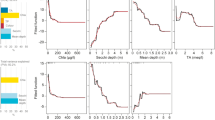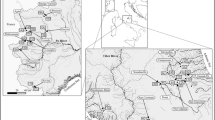Abstract
This study investigates whether the process of pressing and drying a macrophyte host affects community structure and composition of epiphytic diatom communities. Epiphytic diatoms on submerged macrophytes from carbonate rivers and streams in southern Bavaria, Germany were sampled in order to study community structure and composition. Simultaneously, a specimen of the submerged macrophyte was taken to create a collection of dried plants. After 6 months of preservation, diatom samples were taken from the herbarium macrophytes. Detrended correspondence analysis, diversity and evenness results indicate that recent and dried communities are indistinguishable. These results suggest that epiphytic diatom communities sampled from historic herbarium macrophytes can be utilised as bioindicators to assess former water quality.
Similar content being viewed by others
Abbreviations
- EP:
-
epiphyton from vascular plants
- EPh:
-
epiphyton from herbarium specimens of vascular plants
- EB:
-
epibryon, i.e. epiphyton from aquatic mosses
- EBh:
-
epiphyton from herbarium specimens of aquatic mosses
References
C. Cocquyt A. Wever Particlede (2002) ArticleTitleEpiphytic diatom communities on herbarium material from lake Naivasha and Lake Sonachi, Eastern Rift Valley, Kenya Belgian Journal of Botany 135 38–49
European Communities, 2000. Directive 2000/60/EC of the European Parliament and of the Council of 23 October 2000 establishing a framework for the Community action in the field of water policy. Official Journal L 327, 22/12/2000.
K. Krammer H. Lange-Bertalot (1986) Bacillariophyceae-1. Teil:Naviculaceae H. Ettl J. Gerloff H. Heyning D. Mollenhauer (Eds) Süßwasserflora von Mitteleuropa, Band 2/1 Gustav Fischer Verlag Jena
K. Krammer H. Lange-Bertalot (1988) Bacillariophyceae-2. Teil: Bacillariaceae, Ephitemiaceae, Surirellaceae H. Ettl J. Gerloff H. Heyning D. Mollenhauer (Eds) Süßwasserflora von Mitteleuropa, Band 2/2 Gustav Fischer Verlag Jena
K. Krammer H. Lange-Bertalot (1991a) Bacillariophyceae-3. Teil: Centrales, Fragilariaceae, Eunotiaceae H. Ettl J. Gerloff H. Heyning D. Mollenhauer (Eds) Süßwasserflora von Mitteleuropa, Band 2/3 Gustav Fischer Verlag Jena
K. Krammer H. Lange-Bertalot (1991b) Bacillariophyceae-4. Teil: Achnanthes, kritische Ergänzungen zu Navicula (Linneolatae) und Gomphonema H. Ettl J. Gerloff H. Heyning D. Mollenhauer (Eds) Süßwasserflora von Mitteleuropa, Band 2/4 Gustav Fischer Verlag Jena
S. I. Passy Y. Pan R. L. Lowe (1999) ArticleTitleEcology of the major periphytic diatom communities from the Mesta River, Bulgaria International Review of Hydrobiology 82 129–174
H. Rothfritz I. Jüttner A. M. Suren S. J. Omerod (1997) ArticleTitleEpiphytic and epilithic diatom communities along environmental gradients in the Nepalese Himalaya: implications for the assessment of biodiversity and water quality Archiv für Hydrobiologie 138 465–482
F. Round (1991) ArticleTitleDiatoms in river water-monitoring studies Journal of Applied Phycology 3 129–145
C. E. Shannon W. Weaver (1949) The Mathematical Theory of Communication University of Illinois Press Urbana
J. P. Smol H. J. B. Birks W. M. Last (2001) Tracking Environmental Change Using Lake Sediments, Volume 3: Terrestrial, Algal, and Silicious Indicators Kluwer Academic Publishers Dordrecht
R.J. Stevenson Y. Pan (1999) Assessing environmental conditions in rivers and streams with diatoms E.F. Stoermer J.P. Smol (Eds) The Diatoms: Applications for the Environmental and Earth Sciences Cambridge University Press Cambridge
H. Dam ParticleVan A. Mertens (1993) ArticleTitleDiatoms on herbarium macrophytes as indicators for water quality Hydrobiologia 269 IssueID270 437–445 Occurrence Handle10.1007/BF00028041
M. Werff ParticleVan der (1955) ArticleTitleA new method of concentrating and cleaning diatoms and other organisms Proceedings of the International Association of Theoretical and Applied Limnology 13 276–277
Vogel, A., 2004. Diatomeenaufwuchs auf historischen Herbarbelegen als Indikator der ehemaligen Wasserqualität von Fließgewässern. Dissertation an der Technischen Universität München. http://tumb1.biblio.tu-muenchen.de/publ/diss/ww/2004/vogel.html.
Author information
Authors and Affiliations
Corresponding author
Rights and permissions
About this article
Cite this article
Vogel, A., Beier, T., Braun, J. et al. Does the process of drying submerged macrophytes affect community structure and composition of epiphytic diatoms?. Hydrobiologia 541, 237–240 (2005). https://doi.org/10.1007/s10750-004-4669-6
Received:
Revised:
Accepted:
Issue Date:
DOI: https://doi.org/10.1007/s10750-004-4669-6




